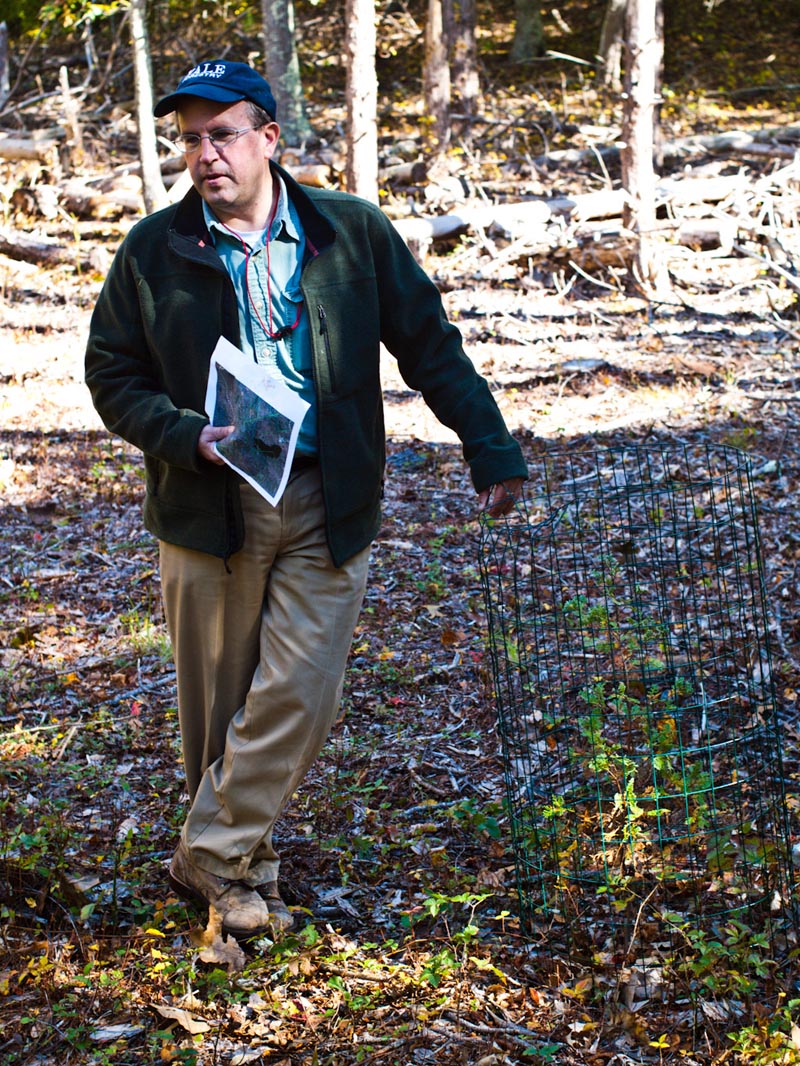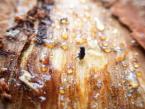Tucked among the red cedars, black oaks and white oaks at Cedar Tree Neck Sanctuary stand six Atlantic white cedars, barely two feet tall.
Last year Sheriff’s Meadow Foundation planted 12 of these cedars at the sanctuary as part of a restoration project; the tree is said to be native to the Vineyard, according to executive director Adam Moore. In 2000, when Mr. Moore worked for the Martha’s Vineyard Land Bank, he and a crew planted 100 of the cedars at the Five Corners Preserve on Chappaquiddick.
Today at that wooded sanctuary about 30 skinny trees stand 20 feet tall, their blue-green feathery foliage popping out among the orange and gold leaves on nearby deciduous trees.
Mr. Moore said his inspiration for the project came from a childhood memory.
“What really got me interested personally was as a kid going to the Cape Cod National seashore where there’s a swamp that’s accessible by a trail,” he said, recalling the Atlantic white cedar swamp in Wellfleet. “I remember walking on the boardwalk as a child, and it’s one of those memories that stayed with me through my whole life.”
Atlantic white cedars grow abundantly from the coast of Maine to Florida in wetlands, swamps, bogs and marshes, creating habitats for tree frogs, turtles, salamanders and snakes as well as grasses, sedges and rushes.
“The tree is also excellent for making shingles and other wood products, because it is naturally rot resistant,” Mr. Moore said.
Hence its extreme decline and even extirpation after European settlement, he said.
In the last three decades, environmental groups have led Atlantic white cedar restoration and protection projects along the East Coast, including in the Pine Barrens in New Jersey, where the cedar population has declined from some 115,000 acres to 30,000 acres.
The late Polly Hill collected wild seeds from the Pine Barrens in 1972; the trees at Cedar Neck are from Polly’s original seeds.
Tim Boland, executive director at the Polly Hill Arboretum, said the Vineyard shares the same geological features as the Pine Barrens, typical of the southern coastal plain. This includes scrub oak, pitch pines and oak trees. “Then they [the Pine Barrens] have a larger extensive area of swamps, and the Atlantic white cedars are in abundance there.”
But it’s unclear whether the cedars ever existed on the Vineyard, Mr. Boland said.
“It is speculated based on previous expeditions that Atlantic white cedars were here, although conclusive pollen evidence has not been found,” he said.
John Brereton, who chronicled Bartholomew Gosnold’s expedition in 1602, recorded his observations of vegetation on the Island in A Briefe and True Relation of the Discoverie of the North Part of Virginia.
“The chiefest trees of this Island, are beeches and cedars,” Mr. Brereton wrote. “The outward parts all overgrown with lowe bushie trees.” He continued later with this observation: “Cedars tall and straight, in great abundance. Cypres trees. Oakes.”
In his 1958 book Wisconsin Vegetation and Climate of Martha’s Vineyard, James Gordon Ogden concluded that Mr. Brereton’s sighting of cedars were Atlantic white cedars, while the trees identified as cypress were probably red cedars, because the Vineyard is too far north for cypress trees to thrive.
But David Foster, Harvard University forest director, said university pollen records show little or no evidence of Atlantic white cedars on the Vineyard.
“It was very common along the southeast coast of Massachusetts in swamps and it served as a very important resource, so it was cut heavily over the last 400 years,” Mr. Foster said. “That makes it a bit difficult to reconstruct its former abundance or even distribution.”
He said compared to sites on Cape Cod and on Naushon (one of the Elizabeth islands), Atlantic white cedars appear to have been either absent or occurring in low numbers.
“The different land masses were isolated at different times,” Mr. Foster said. He noted that the Elizabeth islands are closer to the mainland than the Vineyard.
“It is possible that the trees made it to Naushon and not the Vineyard, which is fascinating,” he said.
He said Vineyard pollen records of the cedars are so sparse that he believes the pollen could have come from the Elizabeth islands or Cape Cod. He also said using pollen records for precise identification of certain species of trees including cedars, pines and conifers is difficult.
“There’s no question that Atlantic white cedars will grow perfectly well on Martha’s Vineyard,” Mr. Foster said. “If Martha’s Vineyard had been connected to the mainland, it probably would be widespread in lots of the swamps. But it’s not.”
Mr. Boland said that regardless of whether it is native, the staff at Polly Hill are using the trees at Cedar Tree Neck and on Chappaquiddick for a provenance study on three populations of Atlantic white cedars.
He said they plan to collect seeds from Cape Cod, where there is a cedar swamp in Wellfleet, and Nantucket, where there are currently two Atlantic white cedars.
“We will test the genetic potential of the three populations and how they perform,” Mr. Boland said. “More northern ones might actually have a problem here, where the southern ones would be experienced with warmer temperatures. We predict Martha’s Vineyard to become as warm as the New Jersey Pine Barrens over time.”
Mr. Moore also wants to examine the adaptive ability of the plant to grow successfully or not on the Island.
He said in the future he would like to create a seedbed in the wetland at Cedar Tree Neck and allow the cedars to re-seed naturally.
“I just love the feeling of being in a cedar swamp,” he said. “With a lot of properties to manage and a species that could use a helping hand, I thought it would be great to restore Atlantic white cedars. Some day when I’m gone, hopefully other children will have the chance to walk through them and really enjoy them, too.”










Comments (8)
Comments
Comment policy »